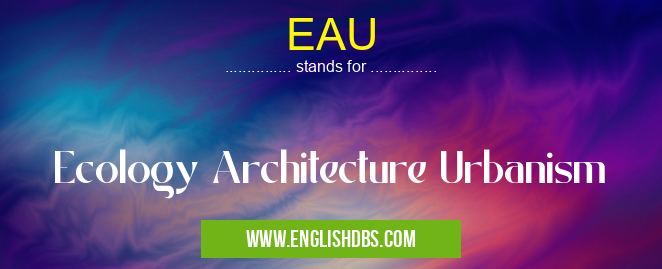What does EAU mean in ARCHITECTURE
EAU stands for Ecology Architecture Urbanism, an interdisciplinary field that integrates ecological principles, architectural design, and urban planning to create sustainable and resilient built environments. It aims to harmonize the relationship between humans, the natural environment, and the built world.

EAU meaning in Architecture in Academic & Science
EAU mostly used in an acronym Architecture in Category Academic & Science that means Ecology Architecture Urbanism
Shorthand: EAU,
Full Form: Ecology Architecture Urbanism
For more information of "Ecology Architecture Urbanism", see the section below.
Key Aspects of EAU
- Ecology: EAU incorporates ecological principles and knowledge of natural ecosystems into design and planning. It considers the impact of human activities on biodiversity, water resources, and air quality.
- Architecture: EAU emphasizes sustainable architectural practices that reduce energy consumption, minimize waste, and promote occupant well-being. It utilizes eco-friendly materials, passive design strategies, and renewable energy sources.
- Urbanism: EAU extends ecological principles to the urban scale. It promotes urban planning that integrates parks, greenways, and natural areas into the built environment. It also encourages compact development, transportation efficiency, and social equity.
Objectives of EAU
- Promote Sustainability: EAU seeks to create built environments that are environmentally sustainable and minimize their impact on natural resources.
- Enhance Resilience: It aims to design cities and buildings that can withstand environmental challenges, such as climate change and natural disasters.
- Improve Human Well-being: EAU prioritizes human health, comfort, and social well-being by creating healthy and livable spaces that connect people with nature.
- Foster Biodiversity: It supports the preservation and restoration of natural habitats within the built environment to promote biodiversity and ecosystem services.
Benefits of EAU
- Reduced environmental impact
- Improved air and water quality
- Enhanced resilience to climate change
- Increased energy efficiency
- Promoted health and well-being
- Enhanced social equity
Essential Questions and Answers on Ecology Architecture Urbanism in "SCIENCE»ARCHITECTURE"
What is EAU?
EAU stands for Ecology Architecture Urbanism. It is an interdisciplinary field that integrates ecological principles into architecture and urban planning. EAU aims to create sustainable and resilient built environments that minimize environmental impact and promote human well-being.
What are the key principles of EAU?
Key principles of EAU include a focus on:
- Ecological Literacy: Understanding natural ecosystems and their relationship to human activities.
- Biophilic Design: Incorporating elements of nature into the built environment to enhance occupant well-being.
- Life Cycle Assessment: Evaluating the environmental impacts of buildings and infrastructure throughout their life cycle.
- Resilient Design: Creating built environments that can adapt to climate change and other environmental challenges.
- Social Equity: Ensuring that EAU principles benefit all members of society.
What are the benefits of EAU?
Benefits of EAU include:
- Reduced Environmental Impact: Minimizing resource consumption, waste generation, and pollution.
- Enhanced Human Health and Well-being: Improving air quality, providing access to green spaces, and promoting physical activity.
- Increased Economic Viability: Saving energy and resources, attracting investment, and boosting tourism.
- Enhanced Urban Livability: Creating walkable, bikeable, and transit-oriented communities that foster social interaction.
- Climate Change Mitigation and Adaptation: Reducing greenhouse gas emissions and building resilience to extreme weather events.
How is EAU being implemented in practice?
EAU is being implemented through various measures, such as:
- Green Building Certification Programs: Establishing standards for environmentally sustainable buildings, such as LEED and BREEAM.
- Urban Greening Initiatives: Planting trees, creating green roofs, and establishing urban parks to improve air quality and reduce the urban heat island effect.
- Low-Carbon Energy Systems: Incorporating renewable energy sources, such as solar and wind power, into buildings and infrastructure.
- Integrated Water Management: Implementing rainwater harvesting, greywater reuse, and permeable pavements to conserve water and reduce stormwater runoff.
- Community Engagement Programs: Involving citizens in planning and decision-making processes to ensure that EAU principles are aligned with community values.
Final Words: EAU is an innovative and holistic approach that integrates ecology, architecture, and urban planning to create sustainable and resilient built environments. By considering ecological principles and promoting sustainable practices, EAU aims to improve human well-being, protect the natural environment, and enhance the overall quality of life in urban areas.
EAU also stands for: |
|
| All stands for EAU |
